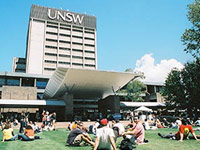|
||||||||||||||||||||||||||||||||||||||||||||
| Software Eng/Biomed Eng - 3749 | ||||||||||||||||||||||||||||||||||||||||||||

The BE (Software Engineering)/Master of Biomedical Engineering concurrent degree program is offered jointly through the School of Computer Science and Engineering and the Graduate School of Biomedical Engineering. Students who are enrolled in a joint program are expected to maintain a credit (=65%) average across courses taken from each of the composite programs.
Program Objectives and Learning Outcomes For further information please visit the school website at http://www.cse.unsw.edu.au/seng
Year 1
And ONE of:
And ONE of:
Year 2
Plus General Education (3 UOC)
Year 3 And ONE of:
And ONE of:
or
BIOM9XXX Software Engineering Electives (15 UOC) General Education (3 UOC) Year 4
Biomedical Engineering Electives (18 UOC)
Software Engineering Electives (18 UOC) Year 5
And ONE of:
OR 2 Biomedical Electives (12 UOC)
Plus Biomedical Engineering Electives (12 UOC) Plus Software Engineering Electives (6 UOC) Preferred Biomedical Engineering Electives Other Biomedical Engineering Electives
General Education Requirements UNSW wants all students to develop skills in a broad range of areas, not just in their specific study discipline, and so students in all degrees are required to undertake a number of general studies courses outside their discipline. It may not be possible for Computer Engineering students to enrol in general education courses that are similar in content to the courses offered in the Computer Engineering degree. For a comprehensive list, see:
http://www.cse.unsw.edu.au/undergrad/current/gened.html Please refer to Program Structure for the Academic Requirements relating to this program.
For information regarding fees for UNSW programs, please refer to the following website: https://my.unsw.edu.au/student/fees/FeesMainPage.html
Industrial Training Requirements All students in the BE in Computer Engineering, Bioinformatics Engineering and Software Engineering programs must complete at least 60 days of approved Industrial Training before the end of Year 4.
Engineers Australia
The professional body for engineering in Australia is Engineers Australia, which has as its first objective the promotion of the science and practice of engineering in all its branches. Engineers Australia has its national headquarters in Canberra and functions through a series of divisions, the local one being the Sydney Division. Within each division are branches representing the main interests within the profession, e.g. civil, mechanical, electrical, engineering management and environmental engineering. Students of an approved school of engineering may join the Institution as a student member (StudIEAust). Student members receive the monthly publication Engineers Australia and for a small fee they also receive The Transactions which contains articles on a particular branch of engineering. Student members are invited to participate in the Excellence Award for Work Experience, the National Young Engineer of the Year Award and to avail themselves of other Engineers Australia services including the Mentor Scheme and industrial experience guidance. For more information and membership application forms, contact Engineers Australia, Sydney Division, Level 3, 8 Thomas Street, CHATSWOOD NSW 2067 - telephone 02 9410 5600 www.engineersaustralia.org.au The Australian Computing Society The peak professional body for computing in Australia is the Australian Computing Society (ACS) - www.acs.org.au The objectives of the ACS can be found here and include: "advanc[ing] professional excellence in information and communications technology, and further[ing] the study, science and application of information and communications technology." Again, students who want to join ACS should go to Member Application Area(s) of Specialisation |
||||||||||||||||||||||||||||||||||||||||||||


